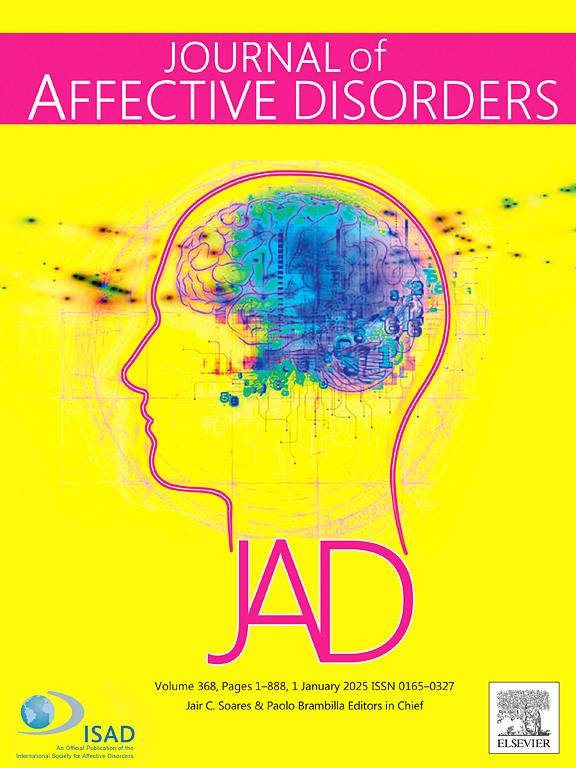在线患者健康问卷-9及其简写版本PHQ-8和PHQ-2诊断重度抑郁症的准确性
IF 4.9
2区 医学
Q1 CLINICAL NEUROLOGY
引用次数: 0
摘要
背景:患者健康问卷-9 (PHQ-9)及其缩写版本PHQ-8和PHQ-2经常被用作在线抑郁症筛查。它们检测重度抑郁症(MDD)的准确性仅在有限数量的学生样本研究中得到检验。目的:评价PHQ-9、PHQ-8、PHQ-2对重度抑郁症的诊断准确性。方法:通过传统和社交媒体活动、德国几个城市公共区域的平面广告以及全国范围内的在线访问调查小组,招募了一般的在线人口样本。参与者年龄在18岁 或以上,在线完成PHQ-9,并通过DSM-5障碍结构化临床访谈电话评估MDD。在横断面设计中计算敏感性、特异性、阳性(PPV)和阴性(NPV)预测值以及曲线下面积(AUC),以评估诊断准确性。结果:总共有n = 790名参与者(574名(72.7 %)女性,年龄:37.4 (SD = 13.9;范围:18-79))用PHQ-9进行筛选(平均 = 11.1;SD = 5.4),并使用SCID进行电话访谈(41.2% %符合MDD标准)。PHQ-9的最佳临界值为11分(灵敏度:0.77;特异性:0.68;AUC: 0.80;净现值:0.81;PPV: 0.63), PHQ-8为11分(灵敏度:0.74;特异性:0.71;AUC: 0.79;净现值:0.79;PPV: 0.64), PHQ-2为3分(灵敏度:0.68;特异性:0.74;AUC: 0.76;净现值:0.77;PPV: 0.65)。描述性地说,年龄或性别对诊断准确性的影响有限。结论:综上所述,PHQ-9、PHQ-8、PHQ-2在线版对重度抑郁症的诊断准确率中等至较好。尽管如此,筛查结果应该谨慎解读,因为许多病例可能会被遗漏或被错误识别。本文章由计算机程序翻译,如有差异,请以英文原文为准。

Diagnostic accuracy of the online Patient Health Questionnaire-9 and its abbreviated versions, the PHQ-8 and PHQ-2, for detecting major depressive disorder
Background
The Patient Health Questionnaire-9 (PHQ-9) and its abbreviated versions, the PHQ-8 and the PHQ-2, are frequently used as online depression screeners. Their accuracy to detect major depressive disorder (MDD) has been examined in only a limited number of studies in student samples.
Objective
Assessment of the diagnostic accuracy of PHQ-9, PHQ-8 and PHQ-2 to detect MDD.
Methods
A general online population sample was recruited through traditional and social media campaigns, print advertisement in public areas of several German cities and via a nationwide online access survey panel. Participants, aged 18 years or above, completed the PHQ-9 online and were assessed for MDD via telephone using the Structured Clinical Interview for DSM-5 Disorders. Sensitivity, specificity, positive (PPV) and negative (NPV) predictive values, and the area under the curve (AUC) were calculated in a cross-sectional design to assess diagnostic accuracy.
Results
In total, n = 790 participants (574 (72.7 %) female, age: 37.4 (SD = 13.9; range: 18–79)) were screened with the PHQ-9 (mean = 11.1; SD = 5.4) and interviewed via telephone using the SCID (41.2 % fulfilling the criterion of MDD). The optimal cut-off was 11 points for the PHQ-9 (sensitivity: 0.77; specificity: 0.68; AUC: 0.80; NPV: 0.81; PPV: 0.63), 11 points for the PHQ-8 (sensitivity: 0.74; specificity: 0.71; AUC: 0.79; NPV: 0.79; PPV: 0.64) and 3 points for the PHQ-2 (sensitivity: 0.68; specificity: 0.74; AUC: 0.76; NPV: 0.77; PPV: 0.65). Descriptively, age or gender had limited impact on diagnostic accuracy.
Conclusions
In conclusion, the online version of the PHQ-9, PHQ-8, and PHQ-2 show moderate to good diagnostic accuracy to detect MDD. Still, screening results should be interpreted with caution as a number of cases are likely to be either missed or incorrectly identified.
求助全文
通过发布文献求助,成功后即可免费获取论文全文。
去求助
来源期刊

Journal of affective disorders
医学-精神病学
CiteScore
10.90
自引率
6.10%
发文量
1319
审稿时长
9.3 weeks
期刊介绍:
The Journal of Affective Disorders publishes papers concerned with affective disorders in the widest sense: depression, mania, mood spectrum, emotions and personality, anxiety and stress. It is interdisciplinary and aims to bring together different approaches for a diverse readership. Top quality papers will be accepted dealing with any aspect of affective disorders, including neuroimaging, cognitive neurosciences, genetics, molecular biology, experimental and clinical neurosciences, pharmacology, neuroimmunoendocrinology, intervention and treatment trials.
 求助内容:
求助内容: 应助结果提醒方式:
应助结果提醒方式:


